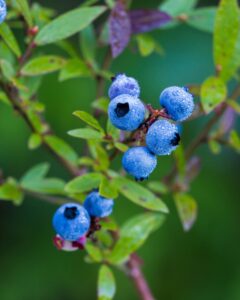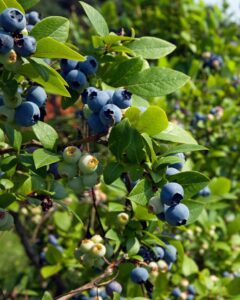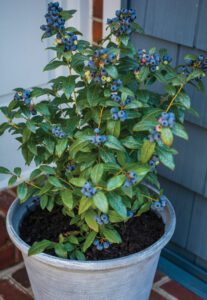April 7, 2025
Grow Your Own Blueberries in New England
If you’ve ever dreamed of stepping outside and picking a handful of sun-ripened blueberries from your own backyard, you’re in luck—blueberries grow beautifully in New England! With the right conditions and a little care, you can enjoy fresh, juicy berries every summer, right from your own garden.
Why Blueberries?
Blueberries are not only delicious—they’re packed with antioxidants and offer year-round beauty. In spring, they flower with dainty white blossoms. Summer brings clusters of blue fruit, and in fall, their foliage turns brilliant shades of red and orange. Plus, they’re a favorite for pollinators and songbirds alike.
A Note on Native Blueberries

Lowbush Blueberry (Vaccinium angustifolium)

Highbush Blueberry (Vaccinium corymbosum)
New England is home to several species of native blueberries, including the lowbush blueberry (Vaccinium angustifolium) and the highbush blueberry (Vaccinium corymbosum)—the same species used in most cultivated varieties. These native plants are well-adapted to our climate and play an important role in local ecosystems, providing food for wildlife and supporting native pollinators.
- Lowbush blueberries are typically found growing wild in open woods or on rocky hillsides. They form a dense, groundcover-like mat and produce smaller but intensely flavorful berries—think of them as the wild cousins of cultivated types.
- Highbush blueberries, which are commonly cultivated in gardens, can also be found growing naturally in wetlands and woodland edges.
If you’re interested in a more naturalistic landscape or want to support local biodiversity, incorporating native blueberry species into your garden is a great option. They’re hardy, beautiful, and contribute to a healthier environment.
Pro tip: Plant a few different varieties for better cross-pollination and a longer harvest season!
The Right Spot
Blueberries love full sun, so aim for a spot that gets at least 6–8 hours of direct sunlight each day. They also need well-draining, acidic soil—ideally with a pH between 4.5 and 5.5. If your soil isn’t naturally acidic (most New England soils are close), you can amend it with soil acidifier or choose a peat moss-based soil mix when planting.
Choosing Your Varieties
For success in New England’s climate, look for cold-hardy, highbush blueberry varieties. Some tried-and-true options include:
- ‘Bluecrop’ – Mid-season, productive, and great flavor
- ‘Patriot’ – Early-season, cold-hardy, and compact (great for small spaces)
- ‘Jersey’ – Late-season, excellent for extending your harvest window
Planting a few different varieties that ripen at different times will keep the berries coming from July into early September. And if you’re interested in preserving a bit of wild flavor, consider planting a lowbush variety in a sunny, well-drained area where it can spread.
Want to Grow Blueberries in Containers?

No garden space? No problem! You can grow beautiful, fruiting plants right on your porch, patio, or balcony. Certain compact varieties are specifically bred to thrive in pots and offer an easy, attractive way to enjoy fresh berries all season long.
At Mahoney’s, we’re excited to offer the Bushel and Berry® collection, designed to be both ornamental and edible, these blueberries are as beautiful as they are delicious. They’re easy to care for and don’t require much space, making them perfect for small-space gardeners, renters, or anyone who wants to bring berries closer to the kitchen door.
You’ll find a variety of exciting flavors and forms—from compact, mounded growers to upright, decorative plants with colorful foliage. Simply choose a large pot with good drainage, use an acidic potting mix, and water consistently. With enough sun and a little love, you’ll be harvesting your own blueberries in no time.
Planting Tips
- Spacing: Space bushes about 4–5 feet apart to give them room to grow.
- Depth: Plant at the same depth they were in the pot, and water thoroughly after planting.
- Mulch: Use pine bark mulch or pine needles to help retain moisture and maintain soil acidity.
- Water: Blueberries like consistent moisture, especially while fruiting. Aim for about 1–2 inches of water per week.
 Pruning & Care
Pruning & Care
Blueberries are low-maintenance, but a little pruning goes a long way. In late winter or early spring, remove any dead or weak branches, and thin out older canes to encourage new growth. Annual pruning helps keep your plants productive and healthy.
You can also feed your bushes each spring with a fertilizer designed for acid-loving plants. Avoid high-nitrogen formulas—they’ll encourage leafy growth at the expense of berries.
A Little Patience Goes a Long Way
Blueberries take a few years to really hit their stride. In the first year or two, it’s often recommended to pinch off flowers so the plant can focus on root development. But once they’re established, your patience will be rewarded with years of reliable harvests.
Harvest Time
Depending on your varieties, your blueberry season in New England can run from late June through August. The berries will turn deep blue, but don’t rush to pick them right away—wait a few days after they turn blue to let them fully sweeten up.
They’re easy to harvest: just give the ripe ones a gentle tug and they should pop right off.
Ready to Plant?
Stop by your local Mahoney’s Garden Center—we carry a great selection of blueberry varieties suited for New England gardens, including cold-hardy highbush cultivars and native lowbush options. We’ve also got the soil amendments and expert advice to help you get off to a great start.
